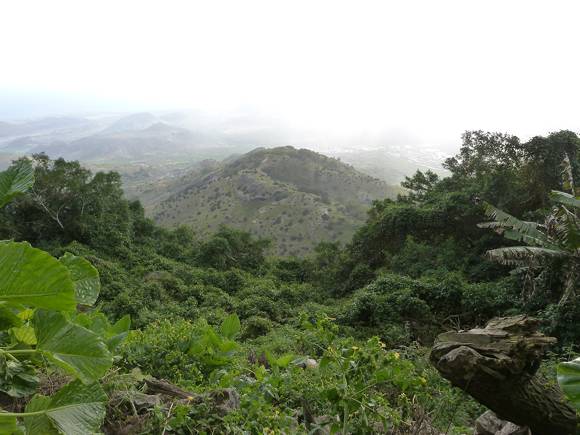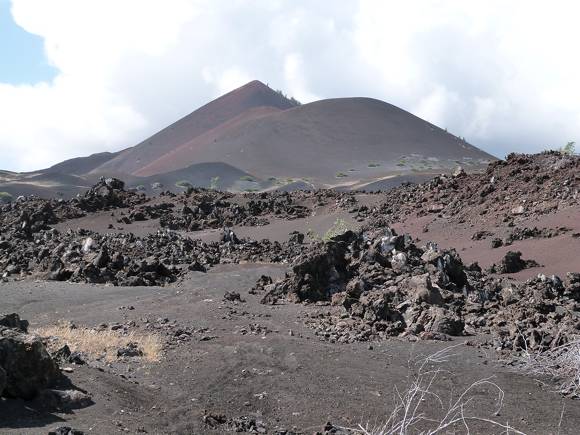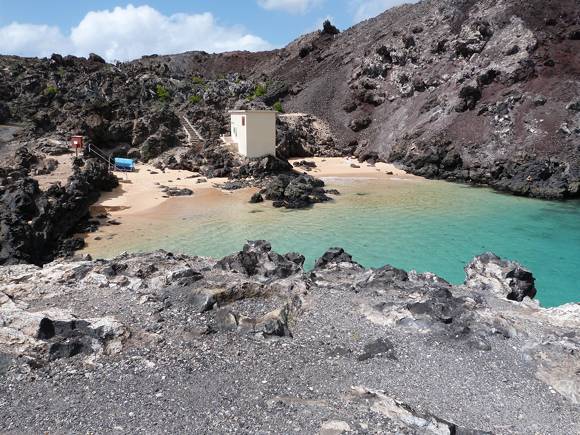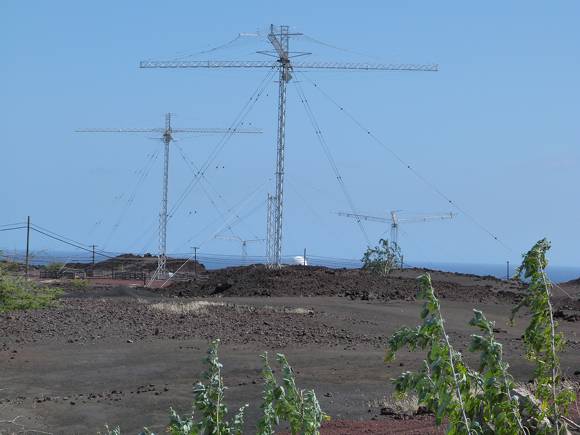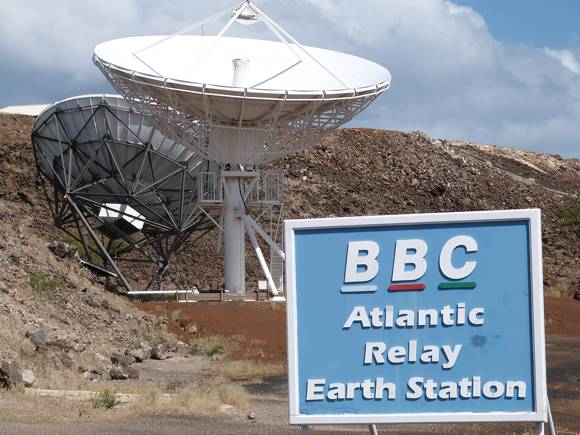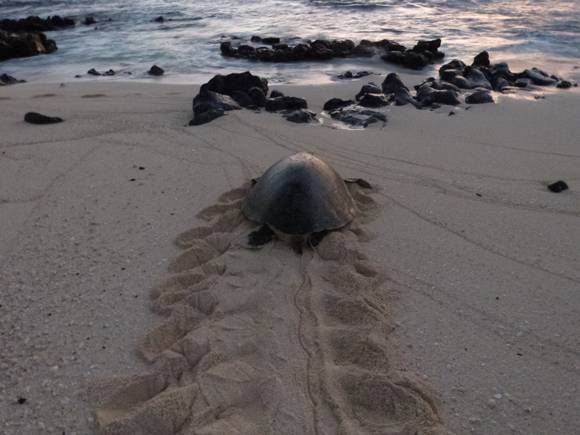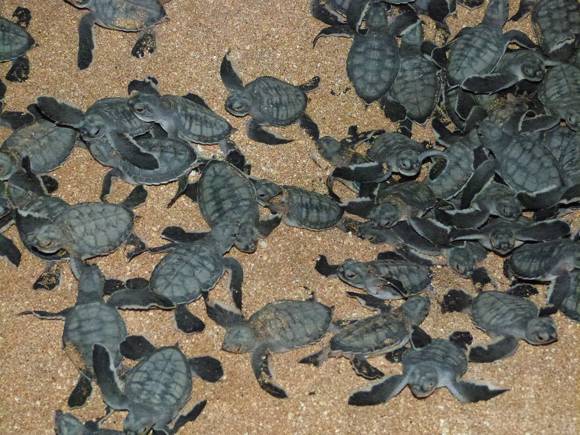Ascension Island

Where in the World are Margie and Peter? Ascension Island!
When we left the island of St. Helena, Peter and I planned to sail directly towards the northeastern tip of Brazil. This would be a non-stop passage of approximately 1700 miles. I wasn’t looking forward to it but we really needed to cover some ground or water, to be more precise…
Numerous delays over the previous month, resulting from mechanical failures of assorted varieties -which I will let Peter describe in his typical swashbuckling, death-defying, blood-curdling way - had really set us back time-wise and we were desperately trying to get to Trinidad by the end of June to meet our daughter Amy and her boyfriend, Dan, who were going to be vacationing there.
We reluctantly decided to skip the island of Ascension, 700 miles to the northwest of St. Helena as the dog-leg to get there and time spent exploring the island would have added several more days to our itinerary and we just didn’t see how we could do it. We were already cutting it close and, as I have said before, cruising does not lend itself to a “schedule.” We knew we were antagonizing the sea gods who do NOT like to be rushed!
So, OF COURSE, on the 4th day out as we were making excellent time towards Brazil and just beginning to get into a comfortable routine of eating, sleeping, reading and alternating “watch” duty, Poseidon reared his ugly head. With a screeching noise, he rips off the small metal base which is connected to (what else?) the autopilot! NOT AGAIN!!!
Well, I won’t steal Peter’s thunder by telling you how he mustered all his MacGyver skills to repair this latest malfunction. Instead, I’ll share with you some thoughts about the delightful island of Ascension where we, luckily, found ourselves anchored three days later…
I guess Poseidon didn’t want us to miss Ascension although the vast majority of the world’s population will certainly never see this place. It’s not on any Tourist Top Ten list because it is so incredibly remote and, aside from some spectacular deep sea fishing and a few birders, turtle watchers and volcanists who stop here from time to time, there’s not much on this little 34 square mile volcanic island to attract attention.
Unless, of course, you are in the military, the space program or the telecommunications industry! Well then…NOW you’re talking!!!
But, first, a little background information…
Ascension Island is located 8 degrees south of the equator smack dab in the middle of the South Atlantic Ocean. It’s approximately 900 miles from Africa and 1100 miles to South America. Discovered in 1501 by the Portuguese explorer, Juan da Nova, Ascension was not continually inhabited until 1815 when the British occupied the island to thwart any effort by the French to stage a rescue mission for Napoleon Bonaparte when he was imprisoned on St. Helena. Back then, Victorian marines built what was known as The Garrison, now called Georgetown. The stone structures are still in use today. These are the Garrison buildings near the wharf on a quiet Sunday morning.
Ascension is one of the British Overseas Territories now and is governed by an Administrator stationed in the capital of Georgetown. He reports to the Governor in St. Helena, who is the Queen’s representative here.
Ascension has no indigenous population. The 600 residents here are mostly from St. Helena and the UK. Aside from the government infrastructure, community services and a few small businesses on the island, most workers are affiliated with the fishing industry, telecommunications companies or service personnel for the military complexes here. There’s no unemployment. You are either working or outta here!
The British Royal Air Force (RAF) and the United States Air Force (USAF) both have bases on Ascension Island and they share the use of Wideawake Airfield which the Americans built here in 1942. There are approximately 150 RAF soldiers, dependents and private contractors from the UK stationed here and about 80 US soldiers, dependents and private contractors from America. Geographically in the middle of the Atlantic, Wideawake plays an important role in the Defense Department strategy of both US and UK military operations.
FYI - Wideawake is the common name for the rare Sooty Tern which is found here on Ascension Island.
The tallest peak on the island is Green Mountain. It’s a popular spot for hiking, picnicking and for a spectacular view. Aptly named, its lush environment provided the source for the island’s fresh water via pipelines to Georgetown in the early 1800’s. Now, the island has its own water desalinization plant.
Green Mountain stands out on Ascension Island for its natural beauty but, considering that most of the landscape here is barren or covered with pyroclastic deposits of fragmented lava, ash, cinders and pumice, it doesn’t have a lot of competition! The rest of the island looks more like this…
Submarine eruptions build up large volcanic cones which emerge above sea level as islands. Ascension Island is the tip of a 3,200 meter high/60 kilometer wide volcanic cone which is approximately 1 million years old. The most recent lava flows are estimated to be about 1,000 years old.
Just how jagged, rocky and volcanic is the landscape here? Take a look at this cute little beach we visited. It’s called Comfortless Cove and you can see why. 20 people would be a big crowd here and other than that little spit of beach, there is nowhere else to sit but on volcanic rock. Ouch!!!
There are approximately 50 Scoria Cones on the island. Asymmetrical in shape, they were formed when lava poured out from a vent after a minor explosion. Here are some of the pictures showing the Scoria Cones and the basalt lava flows. It’s no wonder that NASA choose Ascension Island with its lunar-like landscape to test-drive the moon buggy back in the 1960’s!
Aside from driver-training school for US astronauts who would be tooling around on the moon buggy, NASA had previously set up a facility here to monitor test missiles fired from Cape Canaveral in the mid-1950’s. Today, Wideawake Airfield still plays an important role in the space program. The airstrip here, at over two miles long, is the second longest in the world and stands ready as a back-up landing surface for the US Space Shuttle program. The European Space Program, Ariane, also has a small communications complex here.
But, what really impresses a visitor to Ascension Island is the intricate network of telecommunications wizardry that helps keep the whole world “connected.” We learned from one of the consultants on the US base that electronic equipment on Ascension controls the positioning of 14 GPS satellites that relay information back to the United States!
It all started in 1899 when the Eastern Telegraph Company laid telegraph cable on the sea bed and Ascension Island became the center of communications for the South Atlantic. Now known as Cable and Wireless, the business of communications is reaching to the outer edges of space and Ascension is literally criss-crossed with antennas and satellite dishes and geodesic domes and more high tech gadgets and gismos than you can shake a stick at!!! You can’t tell me that there’s not a lot of SUPER SECRET STUFF going on here!!! I’ll bet you Bond, Moneypenny and “Q” have office space buried underneath one of those Scoria Cones!
Even BBC is here!
But, back on earth, Ascension offers natural phenomenon that rival all the super spy games and cyber-space odysseys.
Let’s Talk Turtle!!! Green Turtle to be more specific…
Ascension Island has the 2nd largest nesting population of Green Turtles in the Atlantic! On average, over 4,000 females have been recorded nesting on the island between November and May each year. What makes this even more amazing is that these females and their male counterparts swim all the way from BRAZIL to mate in the waters off Ascension Island! The distance varies from 1100-1400 miles and the females specifically return to lay their eggs on the very same beach where they were born!!! It takes them about six weeks to swim here from Brazil – all the while fasting because, as vegetarians, they will find very little plant-life along the way.
The female will mate with up to six males over the course of two or three months – not so much because she is a “loose woman” but to guarantee the survival of the species. Courtship and mating take place in the waters near her nesting area and can last for several hours. Wow!!! You go, girl!!!
She will come ashore at night where she will dig a large hole about a meter deep and then deposit her eggs in a pocket.
She will lay between 100-120 soft white eggs in a “clutch” and then, after covering them up will pull her way back to sea exhausted by the effort. At the end of the mating season, she will return to Brazil without a second look back. Well, I bet she takes a quick peek over her shoulder but those little babies will hatch in 6-10 weeks without ever seeing their mother. Bye Bye, Mom!!!
Now, for a first person account of the hatchlings!
Peter and I arrived on Ascension at the very end of the mating season. Even so, we were lucky enough to see eight to ten Green Turtles make their way up the beach each night not far from the spot where Peregrina was anchored. Here’s some “morning after” turtle tracks returning to the sea. If you look hard, you can see Peregrina out there in the distance…
We were told that at the height of the season there might be up to 200 turtles on this beach. It was absolutely covered with little craters where the nesting turtles had deposited their clutches.
And, lucky for us, now that the incubation period was over, there were baby turtles EVERYWHERE!!! We even had the rare opportunity to witness an “eruption” one night!
Turns out, the hatchlings have to work together if they are going to make it to the surface from the warm and comfy confines of their sandy underground nest. One little turtle trying to claw his/her way up and out of the sand would have a very low success rate so what happens is that one or two hatchlings start poking their noses out of their shell and wiggling around which alerts the rest of the clutch that it’s time to go. They all start clawing and clamoring their way to the surface with such frenzy that it is called an eruption. And that is exactly what we saw one night – literally the sand opened up and an explosion of baby turtles just erupted at our feet. OMG!!! They are SOOOO cute!!!
We watched in amazement as they hurtled themselves down towards the water with their little internal GPS systems guiding them along the way. It was absolutely incredible and worth a broken autopilot just to have witnessed this National Geographic moment in person. Clearly, one of the highlights of our circumnavigation!
Another natural-born resident of Ascension Island is the landcrab. Along with a few sea-birds, such as the Sooty Tern, Island Frigate, Brown Booby and Fairy Tern, the landcrab is one of just a few indigenous inhabitants on the island and can be found up around Green Mountain. This, in itself, is a miracle considering the landcrab is born in the sea and has to make the torturous journey through the hot, desert conditions of the lowlands and then along the barren, volcanic landscape until it finds its way to the moist tropical conditions of Green Mountain – all this while walking sideways on ten little appendages with two giants claws upfront. We found this little guy by the side of the road. But, as you can see, we were forewarned…
My last photo is just a really wonderful shot of a typical morning aboard Peregrina. We were joined for coffee by a young couple, Emily and Daniel, (back left) who are working on Ascension for two years in the field of conservation. Emily is working with the Marine Turtle Research Group at the Conservation Centre and Daniel is a Divemaster working with the Department of Fisheries. The other three were crew from the U.S. Navy ship, Pathfinder, which is a survey vessel mapping the sea bottom in the South Atlantic Ocean. They had come to our rescue with a bottle of “biocide” which we needed desperately to clean our fuel tanks which had become contaminated. Three cheers for the U.S. Navy!!!
This is what cruising is all about and we feel so blessed to have met so many wonderful people along the way.
UPDATE: The message above was written on passage from Ascension Island to Brazil. Since then, we have covered almost 2000 miles in the past two weeks and have just arrived Saint Lauren du Maroni which is 16 miles up a river in French Guyana.
--
--
--


